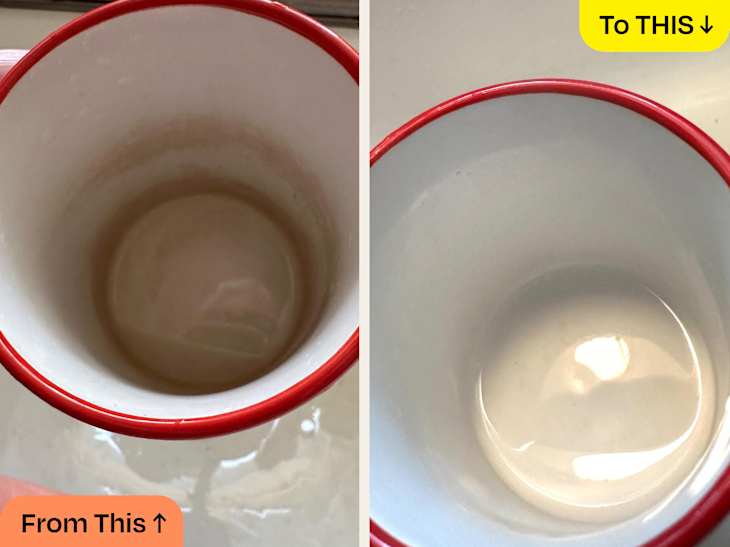

Whose bright idea was it to make the insides of coffee mugs white? As a specialty coffee expert, I’m all too familiar with coffee stains in general, but especially the ones that mark the insides of my favorite mugs, making them look embarrassingly dirty. “Thanks for coming over! Here’s coffee in a gross-looking mug!”
While these stains don’t come out with regular hand-washing or stints in the dishwasher, there are a few different things you can do to get rid of them. But which one is best — and easiest? I was determined to find out! I tried five different methods for how to get rid of coffee stains in mugs, and recorded my results. You might be surprised by the winner!
The Best Way to Clean Stains from Coffee Mugs
The best way to get rid of coffee stains is to scrub your mug with a paste made from water and baking soda. The gritty baking soda helps to remove stains easily, and it won’t leave any lingering smells once you rinse it out.
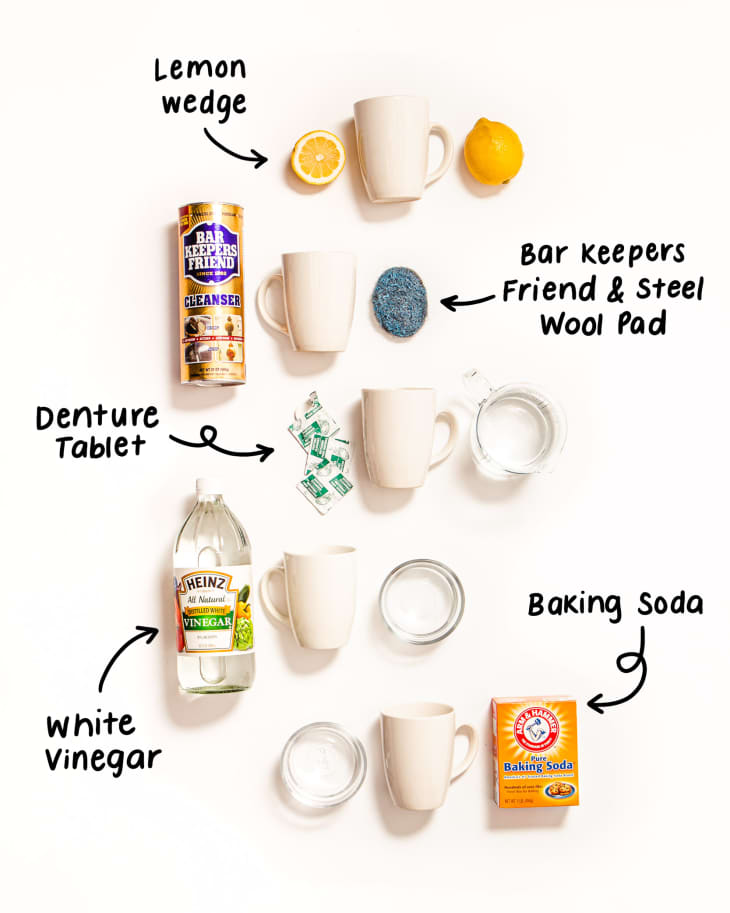
How I Tested the Methods for Getting Rid of Coffee Stains
I rooted around in the cabinet and found my five favorite mugs, which also happened to be the most stained, with white ceramic interiors. I brewed a strong batch of coffee and poured about 2 ounces of liquid in the bottom of each one and let them sit on the counter to really soak in. Once the liquid had evaporated and the coffee oils had left a nice murky layer on top of the already-lingering stains, it was time to get to work by cleaning each one using five popular and proven methods: a lemon wedge; Bar Keepers Friend and a steel wool pad; a denture tablet; white vinegar; and baking soda.
The ratings: I ranked each coffee stain-removal method from 1 to 5, with 5 being the easiest and/or most efficient, and 1 being the hardest and/or least efficient. While each technique and tool managed to leave the mugs relatively clean, some required more work either during or after the job was done. Along with the rating, you’ll find more detailed notes from my testing.
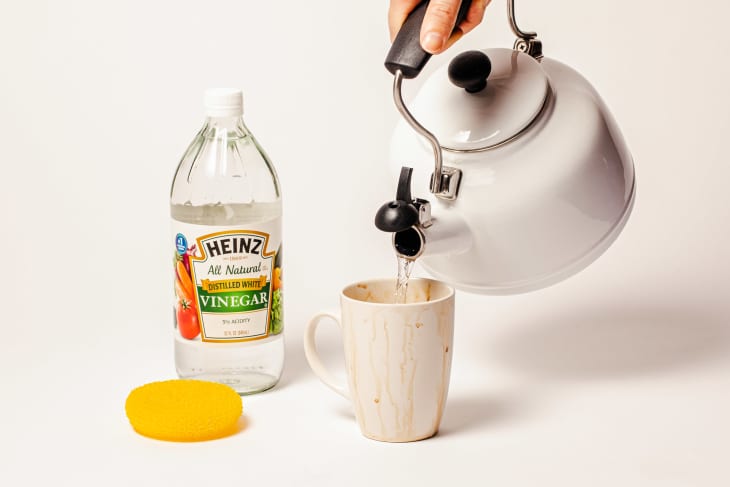
Coffee Stain Cleaning Method: White Vinegar
- Total time: 8 minutes (3 active minutes)
- Rating: 1/5
The method: Fill the stained mug halfway with boiling water, and top with white vinegar. Allow it to sit for 5 minutes, then scrub using a sponge. Wash when done.
How it went: Vinegar can be an effective cleaning agent because of its mild pH, which helps break down tough grease and grime. Unfortunately, unless it’s used in relatively high concentration — like, high enough to make your kitchen smell like a pickle factory — it’s not powerful enough to cut through those super-tough coffee stains and requires quite a bit of scrubbing. While the mug did eventually come clean, it took too much work to achieve the white gleam I was looking for — and way too long to air out the house. Also, this method requires thorough cleaning after the fact to remove the smell and taste of white vinegar.
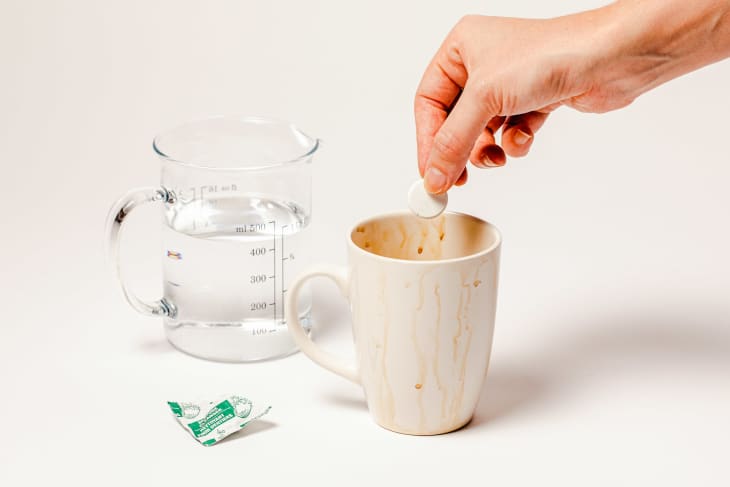
Coffee Stain Cleaning Method: Denture Tablet
- Total time: 20 minutes (5 active minutes)
- Rating: 1.5/5
The method: Fill the mug with warm (not hot!) water, and drop an effervescent denture-cleaning tablet inside. Let sit for 15 minutes, or until the water turns clear. Then, clean the mug as usual.
How it went: Because I love anything that feels like a science experiment, I was drawn to the bubbling, foaming, color-changing process the denture tablet created. Once the bubbling stopped, though, I was slightly disappointed. After letting the off-putting blue water sit there for a few minutes, when I came back, I still had to scrub with a bit of gusto — not unlike when I brush my teeth after a marathon espresso-tasting session. Points for being fun and unusual, but this method came up on the low side in this test, and also required a thorough washing afterward.
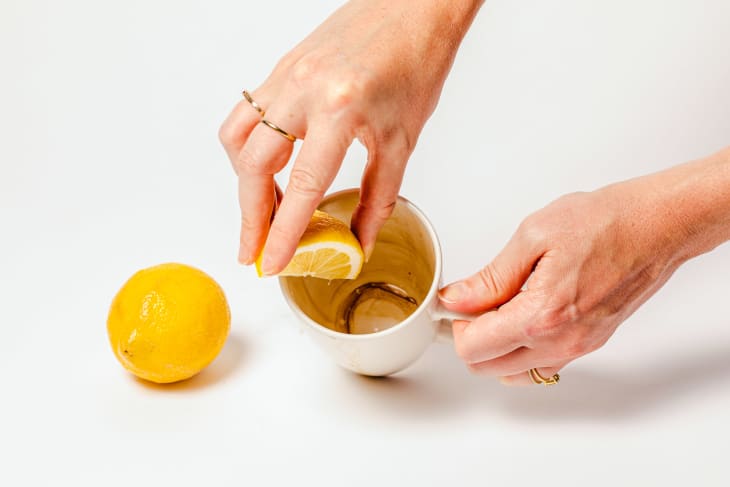
Coffee Stain Cleaning Method: Lemon Wedge
- Total time: 3 minutes
- Rating: 2/5
The method: This method works exactly like how you might imagine. Cut up a wedge of lemon and rub it vigorously along the inside of the mug. Then, wash as usual.
How it went: The only smell that comes close to being as lovely as coffee is the smell of fresh lemon, which is a perk of this technique — but that’s about the only one, aside from how quick it was. It was awfully awkward to try to fit a whole adult human hand and a sizable lemon wedge into a standard-size coffee mug. Plus, that lovely smell also means you need to give the mug a thorough washing after the fact, as it might linger in your next latte.
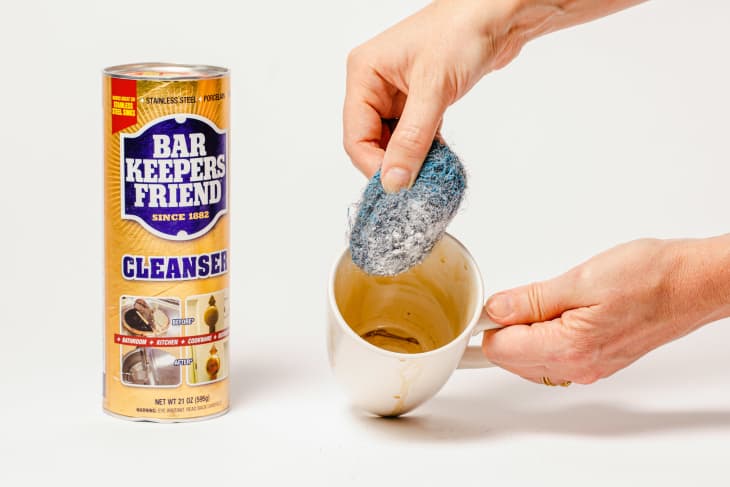
Coffee Stain Cleaning Method: Bar Keepers Friend and Steel Wool Pad
- Total time: 11 minutes (1 active minute)
- Rating: 4/5
The method: Wet the inside of the mug, then sprinkle Bar Keepers Friend powder inside. Allow it to sit for up to 10 minutes, then scrub using a steel wool pad. Wash when done.
How it went: Bar Keepers Friend does the trick like almost no other, which is why it’s a friend indeed! This miraculous cleaning powder cut through tough, soaked-in stains after sitting in the mug for just a short time, and took almost no elbow grease to get it done. However, these results were also due, in part, to the steel wool scrubber, which can be a foe to your cherished heirloom mugs, as scrubbing too vigorously can scratch ceramic or remove decorative paint and glaze. You could absolutely use a softer sponge, but your results won’t be as effective. (There’s also a soft liquid cleanser version of Bar Keepers Friend that works great on ceramic!).

Coffee Stain Cleaning Method: Baking Soda Paste
- Total time: 3 minutes (1 active minute)
- Rating: 5/5
The method: Mix a bit of tap water into baking soda so that you get a thick paste. Dab a scrubby sponge into the paste and use it to clean the mug. (You can also make the paste right in the mug if you don’t want to dirty another dish!). Rinse when you’re done.
How it went: Of course, baking soda wins here; it’s such a great cleaner! While the paste did get a little gloopy in the mug, it was endlessly satisfying to watch it work. Baking soda’s grittiness makes a paste that’s just abrasive enough to get the job done and leaves behind no odor or flavors that could ruin your next brew. Plus, you probably already have a box in your pantry, and it’s only a few bucks if you need to buy more!
The Best Ways to Prevent Coffee Stains
After all that hard work, you don’t want your mugs to become immediately stained again. But why does coffee stains mugs in the first place? Tannins in coffee, a natural polyphenol, are the culprit. As coffee sits in the mug overtime, those compounds adhere to the surface of the mug, resulting in those pesky, unsightly stains. Here are some helpful tips to prevent stains from happening in the first place:
- Rinse immediately: As soon as you finish your coffee, rinse it out immediately with water. The less time the coffee has to sit, the lower the chance that it will stain. Even better, clean your mug immediately with mild dish soap and water.
- Pour when ready to drink: Heat speeds up the staining process, so if you can, pour your cup of joe right as you’re ready to drink it. If it needs to cool down, let it cool in the pot first rather than in the mug itself.
- Choose the right mug: The more porous the mug, the easier it will stain. Plastic and stone are porous, but materials like stainless steel or glass, for example, are less likely to stain in the first place.
Do you have a method you love for cleaning coffee stains out of mugs? Tell us about it in the comments below!

